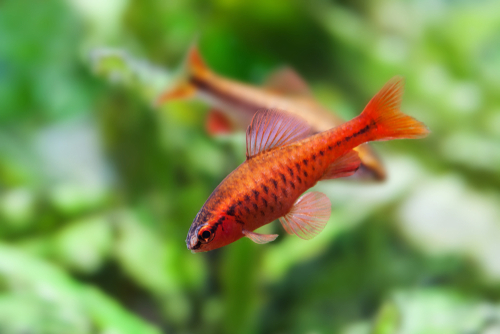Need good tank mates for your Cherry Barb fish? Peaceful fish who live in placid schools or prefer to bury themselves deep in the substrate can make great, non-confrontational companions who won’t bother your Barbs? Since Cherry Barbs are the least aggressive variety in the Barb species, they usually get along fantastically with other docile fish.
You can add gentle kinds of fish such as Celestial Pearls, Kribs, Catfish, Tetras, Gourami, Loaches, and other kinds of mellow freshwater fish that either aren’t territorial or inhabit different layers of the tank.
Check out the 15 best cherry barb tank mates for an optimized community tank.
Contents
The Best Cherry Barb Tank Mates
Also don’t miss:
- Snowflake Eel Tank Mates
- Bristlenose Pleco Tank Mates
- Giant Danio Tank Mates
- Chinese Algae Eater Tank Mates
1. Platy Fish
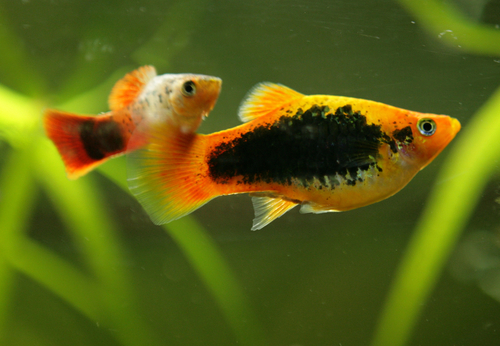
- Scientific name: Poecilia
- Origin: Mexico and Belize
- Size: Over 3 inches
- Care: Easy
Platy fish are a popular choice for tank mates that won’t cause any trouble. They’re also stunning aquatic beauties that have orangey gold scales, bold red stripes on its face, and black spots which fade to a black tail. This is just one of the many kinds of Platy varieties available, so you’ll have lots of colors and patterns from which to choose.
These gentle omnivorous fish can consume whatever you toss in the tank, from flakes and brine shrimp to blood worms.
Pros of keeping with Cherry Barb
- Easy to care for, adaptable and don’t require a complex diet
Cons of keeping with Cherry Barb
- They don’t have a prolonged life span
2. Kribensis
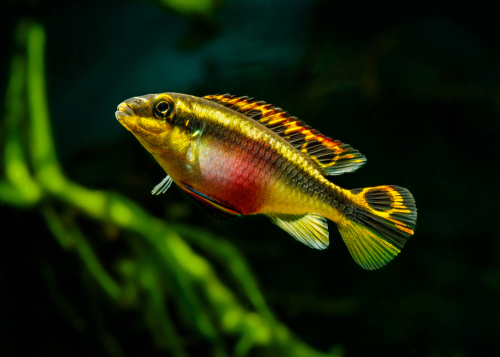
- Scientific name: Pelvicachromis pulcher
- Origin: Cameroon and Nigeria
- Size: 3 inches
- Care: Easy
Hailing from the African continent, a Krib can make a distinctive tank mate for a Cherry Barb. Kribs are rarely aggressive except during breeding seasons, but they are known to get a bit territorial during those times.
These yellow, green, red, or blue fish are a variety of dwarf cichlid, which makes them a good choice if you want to add some cichlids to your aquarium.
These omnivores will eat pretty much anything that you put into the tank, including fresh or frozen brine shrimp, blood worms, larvae, or veggies such as zucchini. They also won’t stir up a tank’s substrate or tear out aquarium plants.
Pros of keeping with Cherry Barb
- Good for cleaning tanks
Cons of keeping with Cherry Barb
- May get slightly aggressive at times
3. Celestial Pearl
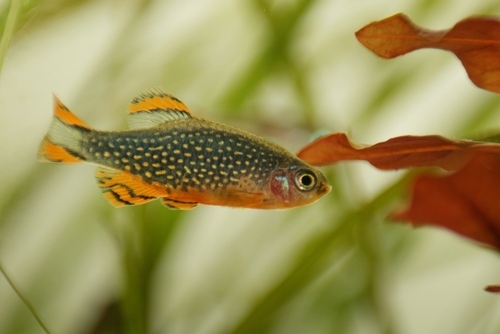
- Scientific name: Danio margaritatus
- Origin: Myanmar
- Size: Under an inch
- Care: Easy
Also known as the Galaxy Rasbora, Celestial Pearls can make perfect tank companions for Cherry Barbs. Their bodies are covered with striking silver, blue, orange, and pearly patterns that are reminiscent of star-studded night skies.
These fish are docile and timid and are compatible with other species if they are the same size and have mellow temperaments. Their care is easy if the tank water is kept clean. Add lots of plants to create a natural-looking environment and feed them a mix of flakes and micro brine shrimp.
Pros of keeping with Cherry Barb
- Thrive in small tanks
Cons of keeping with Cherry Barb
- May breed fast and lead to overcrowding
4. Neon Tetra
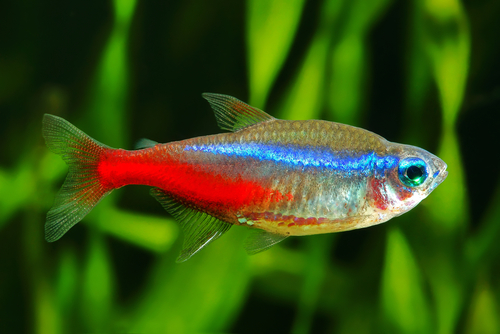
- Scientific name: Paracheirodon innesi
- Origin: Brazil
- Size: Around an inch
- Care: Easy
These sparkling blue and red fish enjoy swimming freely around the tank. The good news is that you don’t need to worry about negative interactions between barbs and neon tetras since both species get along swimmingly.
Neons enjoy an aquarium that has rocks or plants for hiding and filtering light. Just ensure that there aren’t too many floating plants clogging the water’s surface since these schooling fish like to get around.
When it comes to mealtimes, crumble up whatever live worms or frozen shrimp that you plan to feed them. These fish have minuscule mouths, so it’s important to make sure that they can fit the food in their mouths.
Pros of keeping with Cherry Barb
- Mellow moods, attractive, and active
Cons of keeping with Cherry Barb
- Prone to stress and reduced immunity
5. German Rams
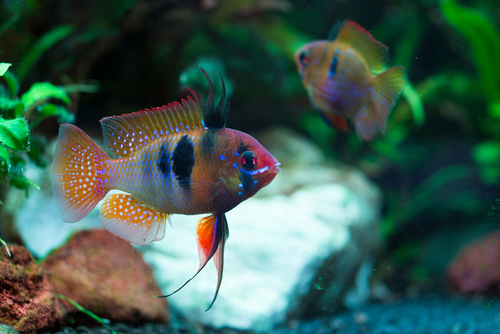
- Scientific name: Mikrogeophagus ramirezi
- Origin: Venezuela and Columbia
- Size: 2 or 3 inches
- Care: Intermediate
A German Ram is a South American cichlid that has a breathtaking range of scale and fin colors. Their iridescent red, blue, purple, black, and yellow shades make them glow with a rippling color through the aquarium water.
Some German Rams, named for a species bred in Germany, look like they have tiny neon spotlights in their tails. You can also identify them by their bold red eyes with a thick black line running through the optical orb.
While these fish will devour tubifex worms, brine shrimp, frozen meat, or sinking pellets, they are super picky when it comes to water temperature and pH.
Pros of keeping with Cherry Barb
- Not picky about their diet
Cons of keeping with Cherry Barb
- Need regular water changes and specific water conditions
6. Dwarf Gourami
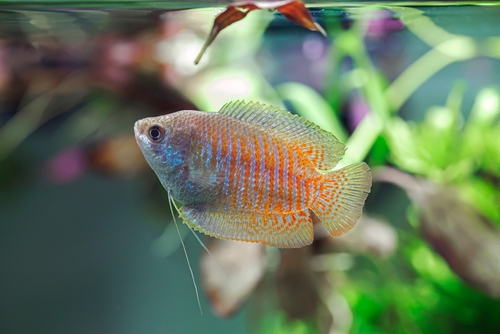
- Scientific name: Trichogaster Ialius
- Origin: India
- Size: 3.6 inches
- Care: Moderately easy
Gentle Dwarf Gourami are flattish disc fish with long floating fins that make them placid and beautiful Cherry Barb mates. There are many popular Dwarf Gourami varieties such as Powder Blue Dwarfs, Honey Dwarfs, and Flame Dwarfs that can make it hard to pick a favorite.
These fish are middle or top-tank swimmers since they need to regularly take in oxygen. While they enjoy lots of worms, veggies, or flakes, they will need room temperatures kept stable within their comfort zone to keep them alive and healthy.
Pros of keeping with Cherry Barb
- Mellow temperament and not fussy eaters
Cons of keeping with Cherry Barb
- Need very specific water conditions
7. Gold Doubloon Molly
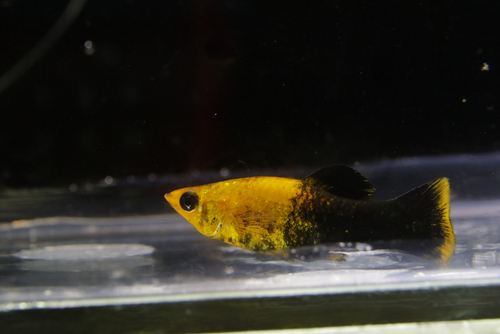
- Scientific name: Poecilia latipinna
- Origin: Mexico, North America, South America
- Size: 4 inches
- Care: Intermediate
This striking little tank mate has big eyes, a mouth that points upwards, and a round golden body. You might notice that its long tail and lower fins are a contrasting black like a gold alloyed coin corroded from being submerged in the ocean for too long.
There are lots of versions of Molly fish, but this is one of the most interesting patterns among fish that do well with Cherry Barb species. Make sure to get enough Mollies to create a school of fish and feed them with a variety of blanched lettuce, spinach, worms, and shrimp.
Pros of keeping with Cherry Barb
- Attractive and generally easy to care for
Cons of keeping with Cherry Barb
- Act hierarchical and mothers may eat their own spawn
8. Paradise Fish
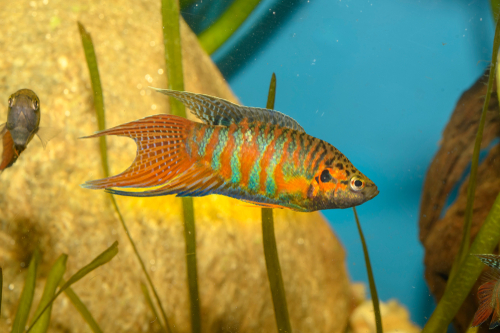
- Scientific name: Macropodus opercularis
- Origin: Taiwan, China, and the Philippines
- Size: 2 inches
- Care: Easy to moderate
If you’re trying to add some fascinating color and movement to your community tank without compromising the mood, try adding a Paradise Fish. This gorgeous species has glimmering shades of orange and blue color that make it stand out in the tank.
Keep in mind that while these fish are generally calm with other fish that are a similar size, they have been known to bully tinier fish who can’t fight back. Since Cherry Barbs are the same size and can hold their own, you shouldn’t have any problem keeping both in the same tank.
This is a good fish for aquarists who prefer a low-maintenance schedule since Paradise fish eat anything from fish flakes to shrimp, worms, or plant matter, and you only need to feed them once a day.
Pros of keeping with Cherry Barb
- Not fussy about food and will eat community fish flakes
Cons of keeping with Cherry Barb
- They might get a little aggressive on occasion
9. Honey Gourami
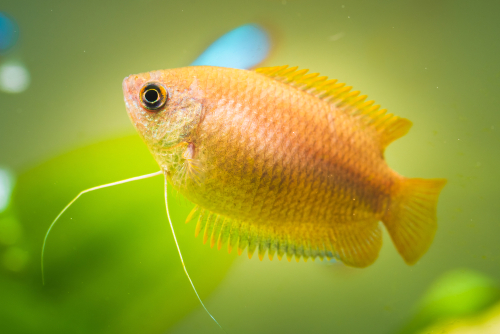
- Scientific name: Trichogaster chuna
- Origin: India, Brazil, and Peru
- Size: Average of 2 inches
- Care: Easy
A Honey Gourami will play the perfect companion when it comes to Cherry Barb aquarium mates. These fish are gentle and shy and won’t ever attack another species. A Gourami’s warm yellow color and scale pattern make it look like a floating honeycomb. Other varieties can have crimson, greenish-brown, or orange-toned bodies.
It’s recommended to add lots of live plants, keep lights low, and provide larvae and vegetable matter for these fish to eat.
Pros of keeping with Cherry Barb
- Don’t require a specialized diet
Cons of keeping with Cherry Barb
- May sometimes consume their own spawn
10. Kuhli Loach
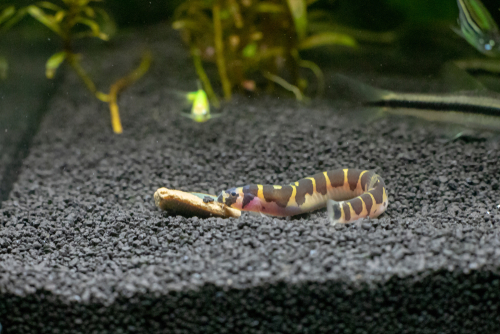
- Scientific name: Pangio kuhlii
- Origin: Greater Sunda Islands in Indonesia
- Size: About 3 inches
- Care: Intermediate to expert
This placid fish is likely to spend daylight hours hiding at the bottom of the tank. At night, they come alive and streak around the aquarium, which can make for interesting entertainment if you’re still awake. You won’t have to worry about these fish messing with their tank mates since they have a completely different sleep cycle.
In a tank, they enjoy larvae, flakes, and sinking pellets that are dropped in at night. They do need rather precise water conditions, so make sure to check that the pH and temperature fit their needs before adding them to a community tank.
Pros of keeping with Cherry Barb
- Top-notch aquarium cleanup crews
Cons of keeping with Cherry Barb
- Nocturnal-only activity and tend to get parasitical infections
11. Diamond Tetra
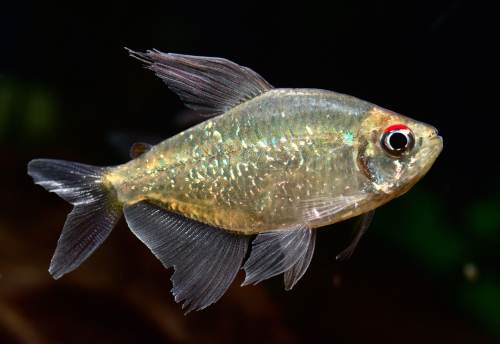
- Scientific name: Moenkhausia pittieri
- Origin: Venezuela
- Size: 2 to 3 inches
- Care: Easy
Pale, shimmering, and opalescent scales with pastel green, purple, or orange shades characterize this priceless fish. This freshwater favorite not only does well in smaller tanks such as 15-gallon aquariums, but it also is a friendly choice for Cherry Barb fish.
These fish are fun to watch as they gambol and play in the water without hurting anyone. They are omnivorous scavengers that will eat anything from plant matter to meaty foods.
Pros of keeping with Cherry Barb
- Easy to care for, active, and gregarious
Cons of keeping with Cherry Barb
- They don’t have a prolonged life span
12. Green Swordtail
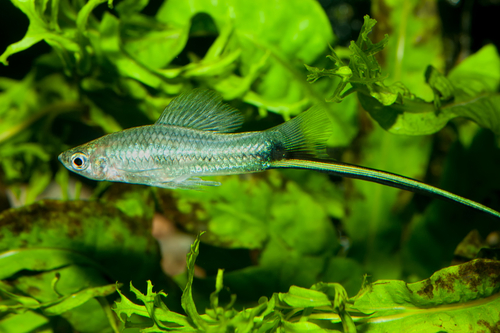
- Scientific name: Xiphophorus hellerii
- Origin: Belize and Mexico
- Size: Over 5 inches
- Care: Relatively easy
If you’re looking for an exotic tank mate that won’t get into fights with your other fish, don’t look any further than a Swordtail. Despite their feisty name, these slender and beautiful fish have a mellow disposition and a friendly attitude toward other fish.
While there are many colorful Swordtail varieties, the Green Swordtail’s gem-green tones and dorsal and caudal fins edged with gold make it stand out. They thrive in smaller tanks if they have enough room to swim, some plant life, and anything to eat from frozen shrimp to flakes, pellets, or live worms.
Pros of keeping with Cherry Barb
- Simple, omnivorous diet
Cons of keeping with Cherry Barb
- Don’t live more than a couple of years
13. Asian Stone Catfish
- Scientific name: Hara jerdoni
- Origin: Bangladesh and India
- Size: 3 inches
- Care: Intermediate
An Asian Stone is a small catfish that has subtle brown and gray mottled or striped marks that help it blend into its surroundings at the bottom of the tank.
While Asian Stone Cats are tiny predators, they also have gregarious natures that are most on display at night. During the day, these compact fish like to burrow into the substrate because it makes them feel safe.
They do well on a mixed, nocturnal diet of live worms, blood worms, and frozen shrimp.
Pros of keeping with Cherry Barb
- Small, calm, and not very active
Cons of keeping with Cherry Barb
- Need a dark tank and don’t adapt to imprecise water temperature, hardness, or pH conditions
14. Rainbow Shark
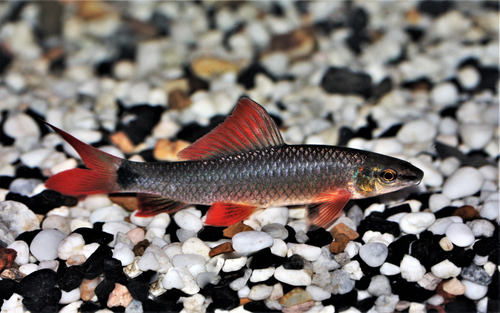
- Scientific name: Epalzeorhynchos frenatum
- Origin: Indochina
- Size: 5 inches
- Care: Easy
These fish aren’t real sharks. Instead, they are a type of placid fish species that doesn’t get enough credit as tank mates for cherry barbs
They have red fins and enjoy a variety of flakes and sinking pellets as long as they can fall to the bottom of the tank.
Pros of keeping with Cherry Barb
- Good tank cleaners
Cons of keeping with Cherry Barb
- May get a little aggressive during breeding
15. Otocinclus
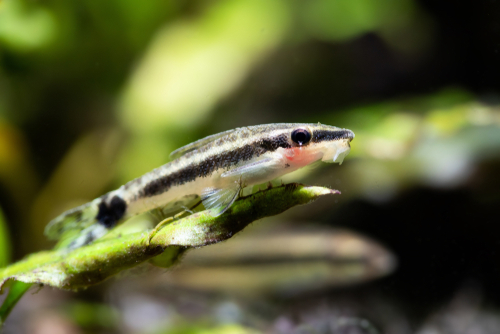
- Scientific name: Otocinclus macrospilus
- Origin: Venezuela
- Size: Close to 2 inches
- Care: Easy
This micro dwarf catfish is one of the most placid bottom dwellers that you can add to a community tank. You can choose from bigger Giant varieties, or gold and silver colors to spice up your aquarium floor.
You’ll want to add many plants, rocks, and caves for them to feel secure during the day. They are active at night when they come out to feed on cooked zucchini, spinach, tubifex worms, or algae.
Pros of keeping with Cherry Barb
- Great tank cleaners
Cons of keeping with Cherry Barb
- Prone to stress
Conclusion
Each of these fish species is a peaceable creature who prefers to move around the tank in sociable schooling circles or likes to keep to itself. Their calm mood makes them excellent companions for Cherry Barb fish.
You can reduce stress or fights by reducing the number of males, keeping the tank clean and at optimal water parameters, and ensuring that everybody gets enough of the right food.

Ian Sterling, founder of Fishlab.com, began his aquarium journey over 30 years ago, driven by a deep fascination for fish and their diverse personalities. His website, Fishlab.com, is dedicated to making fishkeeping accessible and enjoyable, offering beginner-friendly guidance, expert insights, and a community for aquarists to connect and share experiences.


